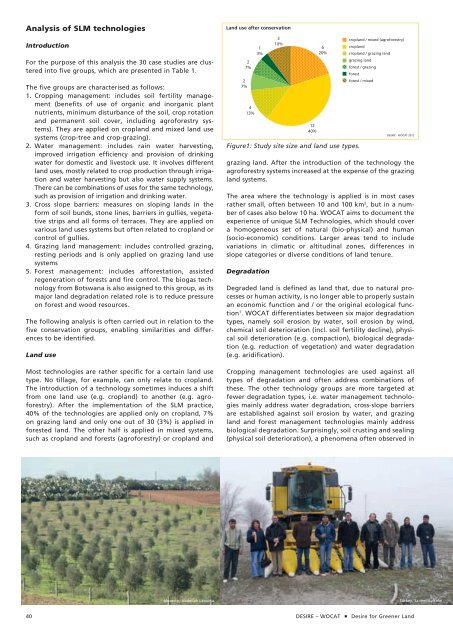Desire for Greener Land
Desire for Greener Land
Desire for Greener Land
Create successful ePaper yourself
Turn your PDF publications into a flip-book with our unique Google optimized e-Paper software.
Analysis of SLM technologies<br />
Introduction<br />
For the purpose of this analysis the 30 case studies are clustered<br />
into five groups, which are presented in Table 1.<br />
The five groups are characterised as follows:<br />
1. Cropping management: includes soil fertility management<br />
(benefits of use of organic and inorganic plant<br />
nutrients, minimum disturbance of the soil, crop rotation<br />
and permanent soil cover, including agro<strong>for</strong>estry systems).<br />
They are applied on cropland and mixed land use<br />
systems (crop-tree and crop-grazing).<br />
2. Water management: includes rain water harvesting,<br />
improved irrigation efficiency and provision of drinking<br />
water <strong>for</strong> domestic and livestock use. It involves different<br />
land uses, mostly related to crop production through irrigation<br />
and water harvesting but also water supply systems.<br />
There can be combinations of uses <strong>for</strong> the same technology,<br />
such as provision of irrigation and drinking water.<br />
3. Cross slope barriers: measures on sloping lands in the<br />
<strong>for</strong>m of soil bunds, stone lines, barriers in gullies, vegetative<br />
strips and all <strong>for</strong>ms of terraces. They are applied on<br />
various land uses systems but often related to cropland or<br />
control of gullies.<br />
4. Grazing land management: includes controlled grazing,<br />
resting periods and is only applied on grazing land use<br />
systems<br />
5. Forest management: includes af<strong>for</strong>estation, assisted<br />
regeneration of <strong>for</strong>ests and fire control. The biogas technology<br />
from Botswana is also assigned to this group, as its<br />
major land degradation related role is to reduce pressure<br />
on <strong>for</strong>est and wood resources.<br />
The following analysis is often carried out in relation to the<br />
five conservation groups, enabling similarities and differences<br />
to be identified.<br />
<strong>Land</strong> use<br />
Most technologies are rather specific <strong>for</strong> a certain land use<br />
type. No tillage, <strong>for</strong> example, can only relate to cropland.<br />
The introduction of a technology sometimes induces a shift<br />
from one land use (e.g. cropland) to another (e.g. agro<strong>for</strong>estry).<br />
After the implementation of the SLM practice,<br />
40% of the technologies are applied only on cropland, 7%<br />
on grazing land and only one out of 30 (3%) is applied in<br />
<strong>for</strong>ested land. The other half is applied in mixed systems,<br />
such as cropland and <strong>for</strong>ests (agro<strong>for</strong>estry) or cropland and<br />
<strong>Land</strong> use after conservation<br />
1<br />
3%<br />
2<br />
7%<br />
grazing land. After the introduction of the technology the<br />
agro<strong>for</strong>estry systems increased at the expense of the grazing<br />
land systems.<br />
The area where the technology is applied is in most cases<br />
rather small, often between 10 and 100 km 2 , but in a number<br />
of cases also below 10 ha. WOCAT aims to document the<br />
experience of unique SLM Technologies, which should cover<br />
a homogeneous set of natural (bio-physical) and human<br />
(socio-economic) conditions. Larger areas tend to include<br />
variations in climatic or altitudinal zones, differences in<br />
slope categories or diverse conditions of land tenure.<br />
Degradation<br />
cropland / mixed (agro<strong>for</strong>estry)<br />
cropland<br />
cropland / grazing land<br />
grazing land<br />
<strong>for</strong>est / grazing<br />
<strong>for</strong>est<br />
<strong>for</strong>est / mixed<br />
DESIRE - WOCAT 2012<br />
Degraded land is defined as land that, due to natural processes<br />
or human activity, is no longer able to properly sustain<br />
an economic function and / or the original ecological function<br />
1 . WOCAT differentiates between six major degradation<br />
types, namely soil erosion by water, soil erosion by wind,<br />
chemical soil deterioration (incl. soil fertility decline), physical<br />
soil deterioration (e.g. compaction), biological degradation<br />
(e.g. reduction of vegetation) and water degradation<br />
(e.g. aridification).<br />
Cropping management technologies are used against all<br />
types of degradation and often address combinations of<br />
these. The other technology groups are more targeted at<br />
fewer degradation types, i.e. water management technologies<br />
mainly address water degradation, cross-slope barriers<br />
are established against soil erosion by water, and grazing<br />
land and <strong>for</strong>est management technologies mainly address<br />
biological degradation. Surprisingly, soil crusting and sealing<br />
(physical soil deterioration), a phenomena often observed in<br />
40 DESIRE – WOCAT <strong>Desire</strong> <strong>for</strong> <strong>Greener</strong> <strong>Land</strong><br />
2<br />
7%<br />
4<br />
13%<br />
3<br />
10%<br />
12<br />
40%<br />
6<br />
20%<br />
Figure1: Study site size and land use types.<br />
Morocco, Abdellah Laouina Turkey, Sanem Açıkalın









